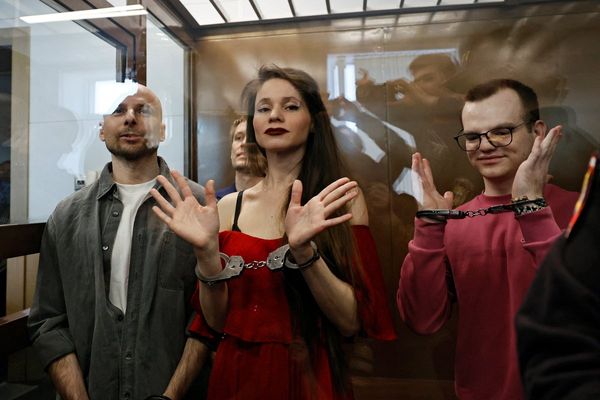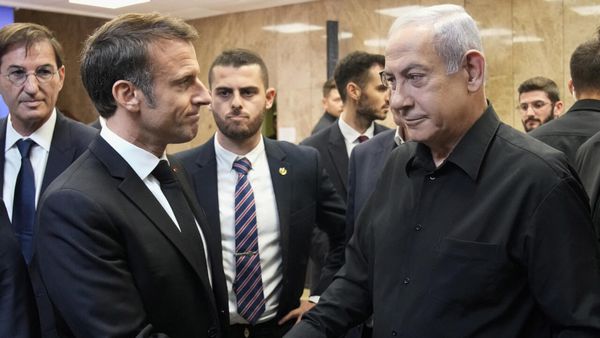
It’s the sound of Goodison Park that gets you. The deep rumble of feet pounding on planks when a blue shirt walks to the corner flag, a thundering drumbeat that vibrates through the legs, up into the torso, direct to the heart. It’s the staccato clatter of wooden seats flipping skyward as a player runs down the wing. The chants started in the belly of lower stands which spill out into the air in swirling eddies, echoing disjointedly around the ground.
It’s the sound of my childhood, the sound of my teens and a specific sound that – at the end of this season – will not be heard again. Everton Football Club are leaving Goodison Park – their home for more than 130 years – and moving to a state-of-the-art 52,888-capacity stadium at Bramley-Moore dock, on the banks of the Mersey.
Wednesday will mark the final derby under the lights at Goodison and among the usual emotions for Evertonians – dread, primarily, despite last year’s anomalous 2-0 victory – there is likely to be a deep sadness, as another milestone passes in this season’s long goodbye.
My dad took me to my first game at Goodison when I was three. I cried all the way through, but it didn’t put him off. One of my earliest memories is being very small and hot in my winter coat, surrounded by a sea of loud shuffling men leaving the Lower Bullens stand. “Mind the little girl, lads,” said one, and space opened up as a group of burly scousers formed a protective wall around me.
Goodison was always a place where I felt safe. Like tens of thousands of other Evertonians, going to the ground with my family was more than my Saturday routine; it was a central part of my identity. As a football-obsessed girl, it meant my passion was taken seriously. I was allowed to talk about football, because I went to the match. Dennis Bergkamp got it. “When you start supporting a football club, you don’t support it because of the trophies, or a player, or history,” he said. “You support it because you found yourself somewhere there; found a place where you belong.”
So if we mawkishly reminisce about our favourite Goodison memories (Barry Horne halting the juggernaut of relegation with a celestial screamer against Wimbledon on the final day of the 1993–94 season, while you’re asking), please indulge us. Why? Because in the multibillion-dollar era of industrialised football – where fan eyeballs are units on a spreadsheet, where clubs are not passion projects but investment vehicles – the bones of a place still matter. History, memory and belonging still matter.
Goodison is, unarguably, a relic. Built in 1892, the oldest purpose-built football ground in England is surrounded by densely packed terraced houses making outward expansion impossible. Inside, the corporate boxes squashed into the main stand resemble badly maintained cattle pens. Watching the game from the back of the lower Gwladys Street or the Lower Bullens stands is like spying out of a letter box, while a wealth of steel struts provide an unrivalled choice of obstructed views.
But relics are precious. They tell stories. The Bullens Road stand, designed by Archibald Leitch, with a distinct criss-cross balcony motif – is 99 years old. The ground has hosted more top-flight games than any other stadium in England. It held the record for attendance at a women’s match for 90 years, after 53,000 people came to watch Dick, Kerr Ladies in 1920. Dixie Dean scored a record-breaking 60th goal of the season at Goodison in 1928. Pelé played here in the 1966 World Cup; Eusébio called it the “best stadium in my playing life”.
“When places like Goodison turn off the lights, you lose a connection with the past,” says Rob Sawyer, from the Everton FC Heritage Society, which can still be found on match days in St Luke’s church, nestled into the corner of Goodison Park. “I think most fans appreciate that the revenue we generate at Goodison doesn’t allow us to be competitive. But when you leave you no longer have that continuous thread going back to the years of Dixie Dean, Tommy Lawton, or more recently, Kendall, Harvey and Ball. You lose that historical connection. That thread is broken.”
Evertonians know we are – somehow, despite many false dawns – gaining an impossibly beautiful new stadium, a new future, even hope. We watch hypnotic YouTube footage of construction of the Everton Stadium – which it will be blandly called until a company forks out millions for the naming rights – like hungry urchins, our stomachs growling.
The new ground will, the club says, generate a £1.3bn boost to the economy of north Liverpool and create 15,000 jobs. Hoping to escape the trap of a soulless new-build, adopted Evertonian Dan Meis’s design will ensure that fans will be as close to the pitch as possible in steep, raked stands, while the roof will sit snugly over seating to lock in sound. The club has made other efforts to make the stadium a home, not only a sleek money-making complex. Outside the South stand, thousands of granite stones are being laid, celebrating births and marriages and remembering loved ones. It’s impossible not to be excited.
And most Evertonians, including this one, understand that the move is necessary. After years of turmoil – including, but not limited to, 17 managers in 20 years, the severing of ties with the Russian billionaire backer Alisher Usmanov, the prospect of insolvency and record point deductions for breaching profitability and sustainability rules last season – Everton desperately need their new owner, The Friedkin Group, to steer the club into calmer, more lucrative, waters.
In an era when 10 of the 20 top-flight clubs are US-owned, with others controlled by private equity firms and authoritarian petrostates, the mantra of modern football is expand or die. Despite an 11% increase in Premier League clubs’ revenue in the 2022-23 season (to a high of £6.1bn), only five clubs made a profit. Bigger stadiums with more spending opportunities are seen as crucial for survival. In the same season match-day revenue increased by 14% across the Premier League, much of that coming from ticket hikes. At Bramley-Moore dock – which cost more than £800m – the lowest-priced adult season ticket will be 15% higher than for Goodison’s final season, although the club will probably still be mid-table on cost.
Back in L4, if approved plans go ahead, Goodison will be bulldozed to make way for a community-focused regeneration project with affordable housing, shops, a care home and healthcare facilities. The club will still own the land, its charitable arm Everton in the Community will still be based there. Statues of Everton greats will remain and the centre circle will be retained “as an open, green space” at its heart. Last year, Historic England issued a certificate of immunity ensuring the ground will not be listed and in effect guaranteeing its demolition. A spokesperson said listing was not appropriate because of past alterations. “It is not the football ground’s buildings that are of historic interest,” they said. “But the place itself and collective sense of memory.”
For many those memories are visceral. My dad died suddenly just before I started my second year at university. He was 47, a few years older than I am now. And although I still loved Everton, dejectedly followed their results and went to watch them play away, I didn’t go back to Goodison. At first it was too raw, too heavy with memory and grief. Then I was too far away, too busy. Finally I had young kids and it was just too difficult.
But knowing that time was running out, like many others swelling the gates this season, I had to make a final pilgrimage. I wanted my son to experience a place that had meant so much to me and my family. He’s nine and football-mad but, despite my – and my brother’s – sustained attempts at indoctrination, he has never supported Everton. Instead – thanks to easy access to the Bundesliga highlights and the mythology of the Yellow Wall – he loves Borussia Dortmund.
Still, the prospect of going to an actual Premier League match was enough of a draw, along with the promise of as much kit as he could carry out of the club shop. So, in last weekend’s cold bright light, we made our way up the M6 to the ground.
At the statue of the Holy Trinity – the trio of Howard Kendall, Alan Ball and Colin Harvey who helped the club romp to the title in 1970 – a volunteer from Everton in the Community clocks my son’s Dortmund top. He starts chatting about how the vertiginous South stand in the new stadium – designed to accommodate 14,000 fans with some safe standing – could be the club’s very own Blue Wall. Then he points at the statue of Ball. “That fella said that once Everton has touched you, nothing will be the same,” he says, and winks. “When you go in there, lad, the rest will mean nothing.”
And then, with the sound of the air-raid siren and Z Cars theme still vibrating through my body, Abdoulaye Doucouré scores the fastest goal in Goodison’s history after 10.18 seconds. I look at my boy, and there is little doubt that he’s been touched. Another three Everton goals later he is swinging his scarf around his head, joining in with Spirit of the Blues. As we walk away from the ground, he puts his hand in mine. “That was one of the best days of my life,” he says. Mine too.
Days like this are very rare as an Evertonian, I tell him. But the hope is – and it is always the hope that kills you – that they could happen more often at the new stadium, hopefully when I take my daughter. The sound will never be the same, but we will create new memories on the banks of the royal blue Mersey. Maybe even new history to sustain fans over the next 30 years.
But, for now, as we say goodbye to the Grand Old Lady in her final season, allow us to be sad, just for a while. Allow us to grieve.







